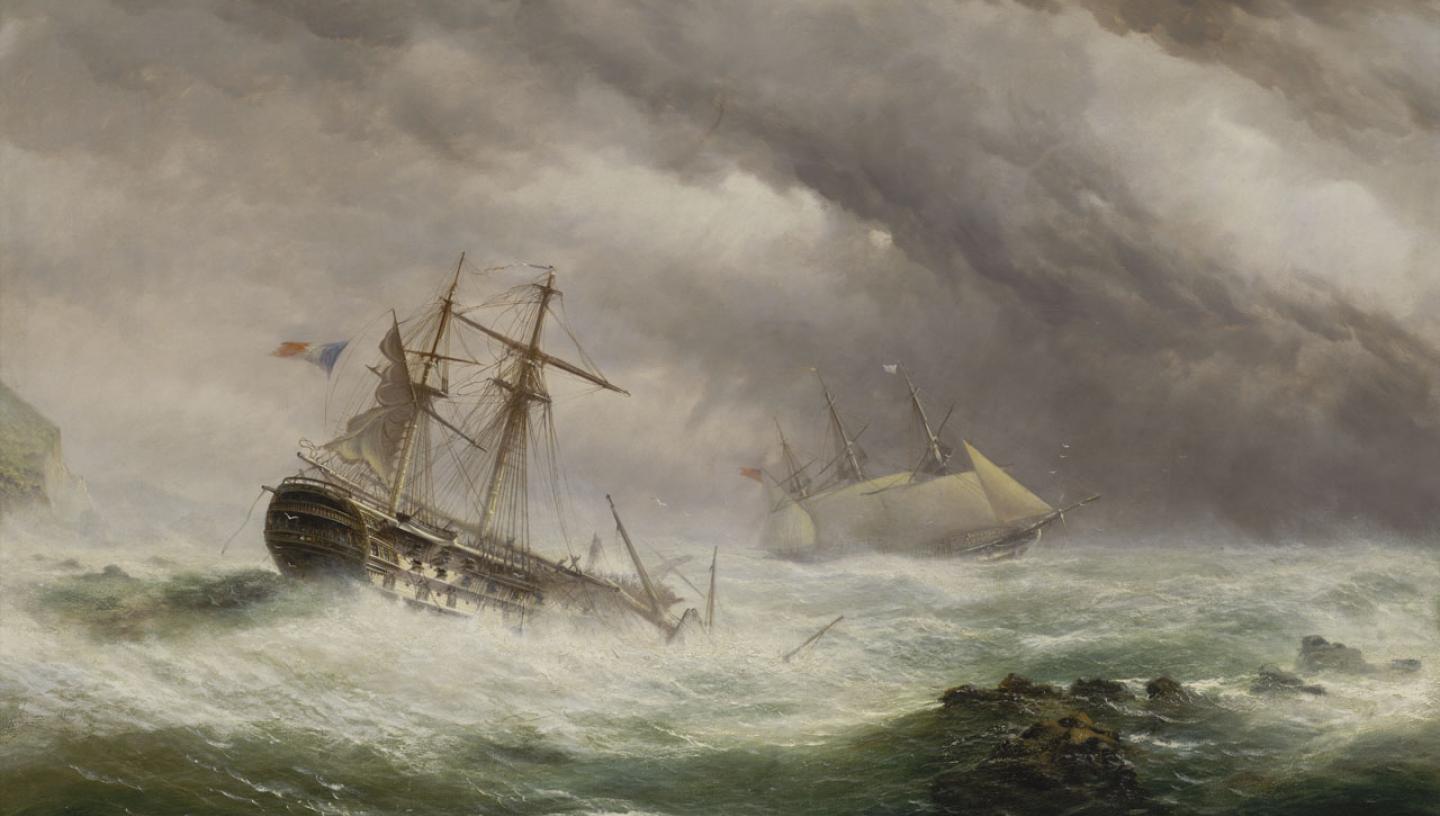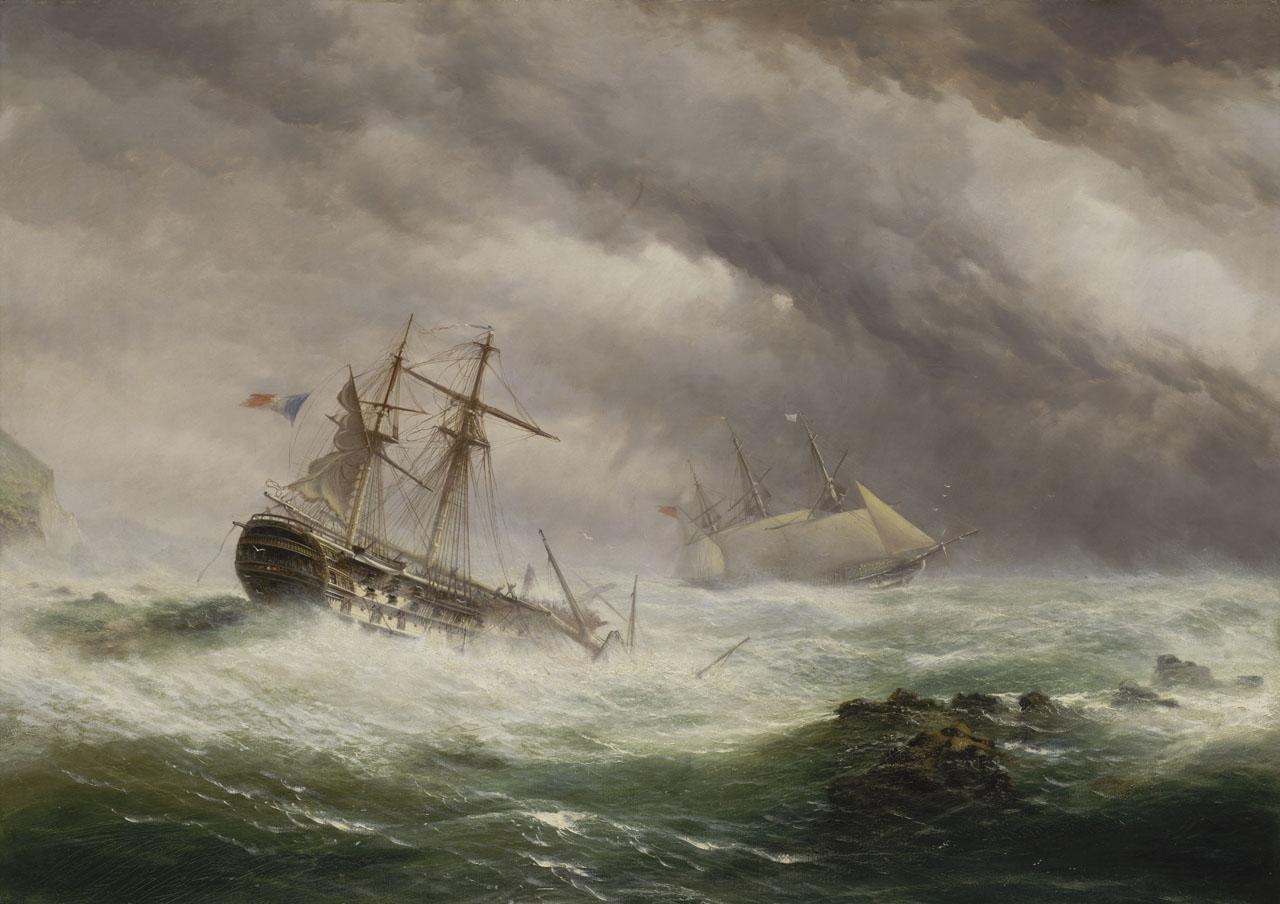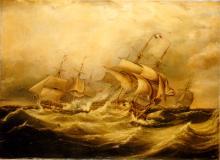
11 Oct 2011
Royal Museums Greenwich provides new insights into 'A Gallant Rescue' by John Christian Schetky
by Pieter van der Merwe, General Editor
This painting went on public display at the Museum in July 2011, for the first time in many years. What follows is a revision of the note posted here at that time, including updated details on the artist and his family kindly supplied by his great-great-granddaughter Sylvia Steer. I am grateful to her for making contact on the matter in September 2011 and also to Anthony Colls and to Jennifer Dunne.
The painter is the so-far little-documented Ebenezer Colls and the picture itself has until recently been something of a mystery. We have long known it relates to another version of the same incident by J. C. Schetky, though who was copying whom, and when, has been uncertain. Moreover, about twenty years ago and quite by chance, I came across another version at Grimsby by Nicholas Pocock, which must have been painted much earlier since he died in 1821. The uncertainties about how all three related have now proved fairly easy to resolve though not quite as tidily as first seemed the case.
In 1871 the well-known naval and marine artist, John Christian Schetky (1778 - 1874) exhibited an almost identical picture of this subject at the Royal Academy under the title 'A gallant rescue; naval incident of the French war' with a brief description of it. It roused considerable interest for reasons explained below, and was immediately purchased for 100 guineas by Admiral Sir James Hope, who presented it to the United Service Club as soon as it came off the Academy walls. In 1891 it was re-shown in the great Royal Naval Exhibition at Chelsea (no. 620), with a longer catalogue text. This had been put together by Hope in discussion with Schetky for the picture's presentation to the Club, and in 1893 was also quoted in full in Sir John Knox Laughton's original 'Dictionary of National Biography' on Endymion's captain: 'Towards the close of the long French war, Captain the Hon. Sir Charles Paget, while cruising in the Endymion frigate on the coast of Spain, descried a French ship of the line in imminent danger, embayed among rocks upon a lee shore, bowsprit and foremast gone, and riding by a stream cable, her only remaining one. Though it was blowing a gale, Sir Charles bore down to the assistance of his enemy, dropped his sheet anchor on the Frenchman's bow, buoyed the cable, and veered it athwart his hawse. This the disabled ship succeeded in getting in, and thus seven hundred lives were rescued from destruction. After performing this chivalrous action, the Endymion, being herself in great peril, hauled to the wind, let go her bower anchor, club-hauled and stood off shore on the other tack.'
The 1871 RA catalogue description adds that Endymion's crew gave 'three British cheers' as they left the scene and that the ship dropped her starboard bower anchor to club-haul, a risky emergency manoeuvre in which the leeward anchor, with a spring (hawser) led astern, is dropped as the ship comes up into the wind: the vessel is then allowed to 'reverse' briefly onto the spring, pulling her stern quickly round to make sail on the opposite tack. The cable and spring have to be cut away and the anchor is usually lost, unless buoyed for later recovery:
'Clubhauling was only resorted to as a measure of desperation in very bad weather, when embayed on a lee shore without room to wear [i.e., 'gybe' with the wind astern], and where there was no prospect that the vessel could tack successfully because of the sea breaking on the weather bow' (John Harland, 'Seamanship in the age of sail' [1984], p. 195)
The exhibition of Schetky's picture in 1871 caused some public debate. For while Paget (1778-1839) commanded the Endymion from April 1803 to April 1805 he did not do so towards the end of the French wars (1793-1815) and nothing of this nature is recorded in his log, which was quickly checked at the time. If the incident happened, he may have omitted it for good reason in terms of the risk he took in hazarding his ship and the lives of his own men, albeit the seamanship involved is a testament to his confidence in them. He could not, however, have prevented it from entering naval lore by word of mouth. Laughton - one of the leading naval historians of his time - nevertheless dismissed it as 'improbable' in his 1893 DNB entry.
There things rested until 1913, when the Revd Edward Paget, Dean of Calgary, Canada, and Sir Charles's grandson, published a 'Memoir' of him in which he devoted a chapter to 'A Gallant Rescue'.* This testimony appears so far to have been overlooked. Edward Paget reports the story was well known in the family, originally from Sir Charles himself and that Schetky (according to the latter's sisters) also heard it from him directly, since they were contemporaries and knew each other well. He was also not the first to depict it: for in 1807, Sir Charles had commissioned a previous picture of it from Nicholas Pocock (1740 - 1821). By 1913 this had descended to Edward and, though not now well-known, appeared (when this piece was first written) to be the one today in the local art collection at Grimsby.
There is, however, a snag. For while the Pagets certainly had such a picture, it appears to have been another version since, if the Grimsby records are correct, theirs was presented in 1871 by the Earl of Yarborough: he was High Steward of Grimsby but had no personal connection with the Pagets as far as can be seen. That would mean the Grimsby canvas cannot be the one inherited by Edward Paget and used to illustrate his 1913 'Memoir'. The only clue to an alternative source of the (B&W) illustration there is its apparent tone: that is, it looks lighter than the dark and stormy Grimsby oil, which might suggest that it was a watercolour version, for example. The original, whatever it was, in due course passed to Sir Charles's fourth daughter Georgina who in 1841 married Captain William Henry Kennedy (d.1864) and on her death in 1901 to Edward Paget, her nephew.
It must presumably have been this one, which he knew when owned by Georgina Kennedy, that Schetky based his oil. One of Schetky's sisters later told Edward that this was painted about 1866, though only exhibited in 1871. The 'Memoir' further confirms that the description, quoted above, was written by Hope and that the misleading dating of the incident to the end of the French wars was probably a slip of memory. Also that Sir Charles - who had other risky manoeuvres to his name - had not reported it officially since contrary to his specific instructions to destroy enemy shipping, let alone more general regulations. Edward also recalled his father's report that Sir Charles's particular worry in not doing so was how otherwise to account to the Admiralty for Endymion's loss of the two anchors involved.
He nevertheless had Pocock - the leading marine painter of his day - depict the episode for him, in one or more versions. Laughton, by 1913, had also told Edward that he did not know of Pocock's painting -or, presumably, the family tradition - when he wrote Sir Charles's DNB entry some 20 years earlier. Edward himself made some enquiry to see if the French ship could be identified, though this got nowhere, and reproduced all the relevant albeit largely circumstantial evidence he had gathered on the truth of the incident. In sum, there is no reasonable doubt that it happened, though exactly when in the 1803-05 period, where on the northern Spanish coast, and which French warship was involved remain unknown. The remaining questions are therefore, first, what was the presumed second version of the Pocock (i.e. oil or watercolour) which remained in the Paget family until at least 1913; and, second, where is it now? One would have thought that Sir Charles would have commissioned an oil - and it may indeed still be that at Grimsby, if it was disposed of before 1871. If so, his family appear to have had another and now unlocated version, possibly in watercolour, for much longer. It is that one which Edward Paget later had on his walls in Canada when he wrote the 1913 'Memoir', and he may himself not have realized that there were perhaps two versions. Though not conclusive, this is the most probable explanation to fit the currently available facts.
Colls's picture is the same general composition as both the Pocock and Schetky versions and it is safe to assume it is based on the latter, following its exhibition at the RA in 1871. It is, however, one of a same-size pair of which the other (BHC0482) shows the start of the action in which the Indefatigable and Amazon drove the French Droits de l'Homme onto the Brittany coast in 1797, in equally stormy conditions. Colls copied this from a print of a painting by W.J. Huggins and until the 1980s the present picture was itself mistakenly thought to show the end of the same episode. All of the Endymion pictures show her on the port tack as she prepares to drop her sheet anchor for the French two-decker, before bearing up into the wind, club-hauling at the cost of losing her starboard bower anchor, and clawing offshore on the starboard tack. The Schetky version remains in the former United Service Club building, London, now headquarters of the Institute of Directors.
Charles Paget was fifth son of the first Earl of Uxbridge and entered the Navy in 1790. Well-connected and competent he rose rapidly and had early success as a frigate captain. In 1804, in the Endymion, he became rich from his share in the capture of four Spanish treasure ships. After other commands as a captain and rear-admiral, he was promoted vice-admiral in January 1837 and posted to command the North America and West Indies station. He died of yellow fever in 1839, at St Thomas, Jamaica.
Colls was a marine painter who exhibited pictures at the British Institution, 1852-54, from an address in Camden Town but practised for a longer period. His work is competent and attractive, and he was certainly prolific since examples regularly appear on the market. His dates were not known until about 2004 when a genealogical web posting stated that he was born in 1812 at Horstead, Norfolk, (on the outskirts of Coltishall), into a family with a local history as owners of water mills. His grandfather was John Colls, miller and farmer, who with H. P. Watts rebuilt Horstead Mill in 1789, was its part owner until 1797, and died in 1806. He had a son, Richard, who became a flour merchant for the family product in London. The latter's eldest child, also Richard (1802-80) was a still-life painter and photographer; Ebenezer - born on 1 July 1812 - was fourth child and second son and the sixth child and youngest boy was Lebbeus (1818-97) who became a Bond Street picture dealer and gallery owner. Ebenezer was both a picture dealer and an artist. How his artistic career began is unclear but he initially went to sea as a midshipman in the East India Company, which explains where he gained knowledge of ships. He made three eastern voyages, first in the Indiaman Rose (955 tons) from May 1828 and then two more in the larger Edinburgh (1326 tons) from March 1830 and May 1832 respectively. After leaving the sea he apparently made regular summer visits to the Channel Islands to sketch, and also along the south coast and to the naval ports. In January 1841 in the Thanet area (in or near Ramsgate) he married Harriet Beal and they had four daughters and three sons who figure in the St Pancras, London, census returns of 1851 - 81: Richard, the eldest son (1844-1920), became a bookseller. Walter (1857-1938) became a clerk and Henry (1847-83) also a bookseller and later hotel keeper in Brighton, though not a successful one since he eventually went bankrupt. Ebenezer's eldest child, Harriet (1842-88), initially taught music and Sarah (1846- 1919) became an accountant and later ran a private school in Hampstead. The third and fourth daughters were Isabella (1849-85) and Florence (b.1865). In the 1851 census Ebenezer's profession is given as 'picture dealer'; in that of 1861 'marine painter'; in 1871 he was living on ' "Dividends" ' (with the landscape painter, Edmund Gell, a boarder in his house) and in 1881 he is again called 'artist'. His final address from before 1871 was 79 King Henry's Road, Regent's Park, and he died there aged 75 on 23 September 1887 ('Morning Post', 28 September). His widow died at the same address on 2 December 1916, her age being given as 94, which suggests birth in 1822 though she was only baptized at St Laurence, Thanet, on 25 December 1825.
A significant correction in this revised note is that the marine painter Harry Colls (1856- c.1908), and his brother Walter Lebbeus Colls (1860-1942), engraver and photographer, both of whom had successful artistic careers, were not Ebenezer's children but his nephews, sons of his brother Lebbeus, who had seven children in all.
* Edward Paget's Memoir of the Hon 'ble Sir Charles Paget... was originally privately printed in Toronto in 1911, with his own autobiographical reminiscences appended. The 1913 London edition omitted most of these and included further information, especially on the matter of the 'Gallant Rescue', from further information he gathered on a visit to England in 1912.

